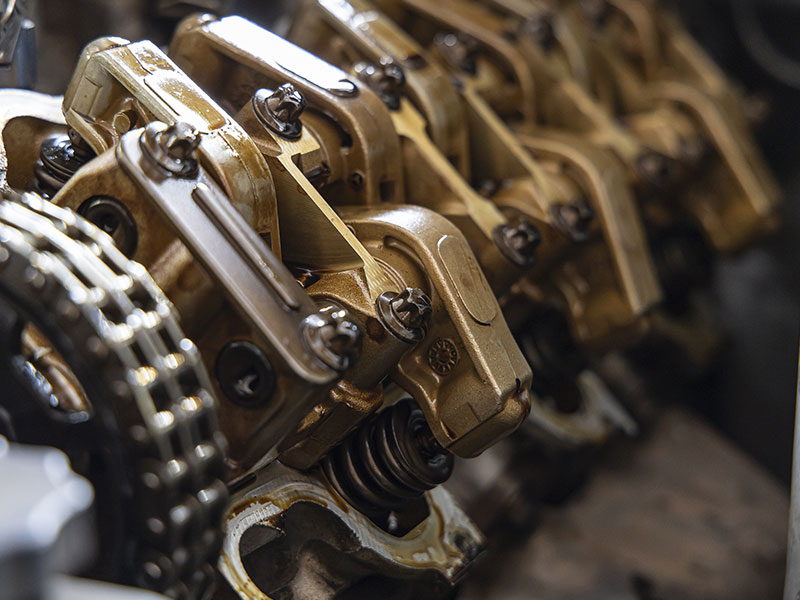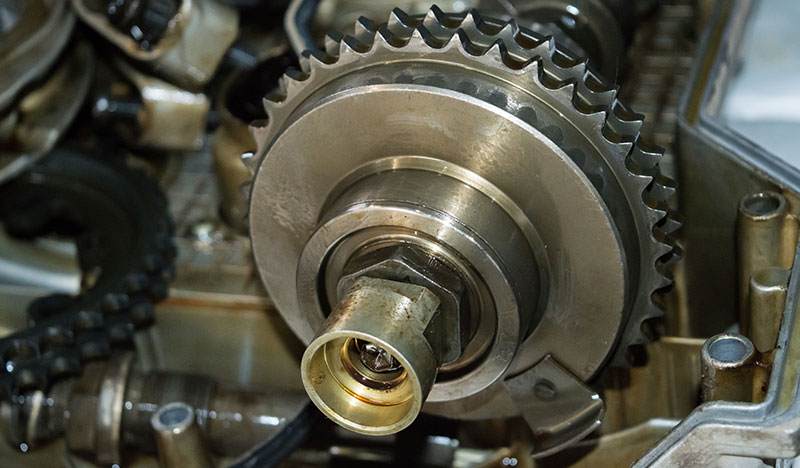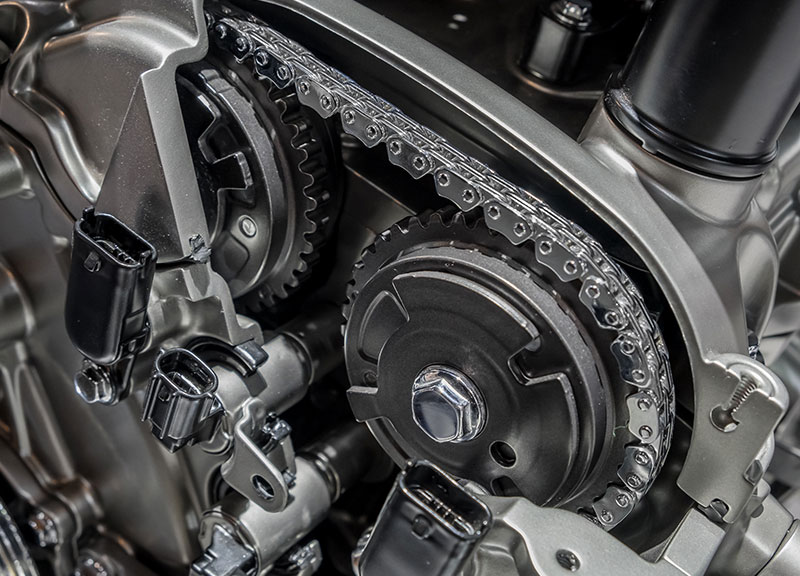We work in with reconditioners from around the country and we are members of the NZERA (New Zealand Engine Reconditioners Association) and normally offer a same day service, next day if your request comes in at the last minute - so - ring us, tell us what you have, and when you need it; and, if you need further advice, our team will be more than happy to guide you on how to deal with whatever it is that poses as a problem.



The purpose of degreeing a camshaft is to ensure that it is phased correctly with the crankshaft. Some factors that may cause improper positioning are:
The important factor to remember is that camshaft position pr phasing to the engine is extremely important for the engine to operate at maximum efficiency.
Equipment needed to properly “degree” in a camshaft. They are available at Franklin Cams and are as follows:
NOTE: Refer to your spec card for maximum lift and check your dial indicator to be sure it has sufficient range to measure the full cam lift.
There are several accepted ways to degree a camshaft. At Franklin Cams, we feel the intake centreline method is the easiest and most accurate. This method of cam degreeing is very practical and indifferent to design characteristics. It simply involves positioning the centre, or point of maximum lift, of the #1 intake lobe with top dead centre of the #1 piston. The intake centreline method still requires accuracy to be correct, but it is somewhat more forgiving. Once you have degreeed a camshaft using this method, you will be surprised at its ease. We also recommend positioning the dial indicator on the #1 intake retainer because lift measurements will include and deflection that may occur in the pushrod and rocker arm. This makes the degreeing process as accurate as possible in relation to what actually goes on inside the engine.
Step 1: The camshaft and timing set have been installed. Make sure that the timing marks on both the cam gear and crank gear are aligned properly per the cam installation instructions. Use chalk or similar marker to better define the marks.
Step 2: For example, we have our cam card and it suggests we install the cam on 106 degree intake centreline. Install all the rocker arms and pushrods in the motor as normal. On #1 intake lobe, install the solid lifter in place of the hydraulic lifter. If a solid lifter or roller cam is being checked, use that respective lifter. Adjust the #1 intake lash to exactly zero. Do not pre-load the lifter. Next, adjust the #1 exhaust last to zero. You should be able to turn both pushrods with your fingers easily.
Step 3: Attach the pointer to the block. Many people will make a pointer out of some sort of rigid, yet manageable wire. A stiff coat hanger wire works well.
Step 4: Attach the degree wheel to the balancer and install the assembly on the crankshaft. There are several ways to attach wheel to the crankshaft. In our example, the degree wheel is mounted to the balancer. The crank may be rotated from either the front or from the flywheel end. Obviously, if the engine is in the car, you must rotate from the front. Remember, the greater the leverage, the smoother the crank rotation, thus more accuracy. NEVER use the starter to turn the engine while degreeing the cam.
Step 5: Before installing the piston stop, rotate the crankshaft to get the #1 piston in approximate T.D.C position with both the intake and exhaust valves closed. This can be a rough guess, but it can save you from making a mistake later. Adjust your pointer to zero or T.D.C on the degree wheel.
Step 6: Turn the crankshaft opposite the motor rotation approximately 15-20 degrees. This will lower the position enough to allow the T.D.C. stop to be installed in the spark plug hole. Screw in the piston stop until it touches the piston. Continue to turn the engine in the same direction until the piston comes back up and touches the piston stop. Mark the degree wheel with a pen or pencil on the number the pointer is on. Turn the engine in the other direction, same as motor rotation, until the piston comes back up and touches the piston stop. Make a mark on the number the pointer is on.
Step 7: Remove the piston stop after marking the two points on your degree wheel. Rotate the crankshaft to the midpoint of the two marks. This point is T.D.C. for cylinder #1. Without rotating the crankshaft, adjust the degree wheel to read 0 degrees at the pointer. You are now ready to locate the intake lobe centreline relative to T.D.C. If you are not absolutely sure that your 0 degree mark is set at T.D.C, repeat this procedure. This step by step is critical to proper cam alignment.
Step 8: Attach the dial indicator to the dial indicator mount. Position the dial indicator mount so the tip will contact the retainer of the 31 intake valve. It is important that the indicator plunger be parallel to the valve stem. Any variance in the angle of the indicator will introduce geometric errors into the lift readings.
Step 9: Rotate the engine in the normal direction of crankshaft rotation until you reach maximum lift. The dial indicator will change direction at the point of maximum lift. At this point, set the dial to zero.
Step 10: Back the engine up (opposite normal rotation) until the indicator reads .100”. Turn the engine back in the normal direction of rotation until the dial indicator reads .050” before maximum lift. Record the degree wheel reading.
Step 11: Continue to rotate the motor over in its normal direction of rotation until the indicator goes past zero to .050” on the closing side of maximum lift. Again, record the degree wheel reading.
Step 12: Add the 2 numbers together and divide by 2. That number will be the location if maximum lift of the intake lobe in relation to at the crank and piston. This is the intake centreline. For example: The first degree wheel reading was 96 degrees. The second reading was 116 degrees. These 2 numbers (96+116) added together will be 212. 212 divided by 2 will equal 106. Your actual intake centreline is 106 degrees. Refer to your cam spec card and we see that the recommended intake centreline for your camshaft is 106 degrees. Everything is where it should be.
In the event that your camshaft did not degree in as per manufacturers specs, it will be necessary to either advance (move the cam ahead) or retard (move the cam back) the cam to meet suggested intake centreline. Depending on the motor application, there are several different suggested methods for advancing or retarding the camshaft.
One common method is by use of a crank gear with multiple keyways each one being at a slightly different relationship to the gear teeth. A second method is to use offset bushings that fit on the cam pin and in the cam gear. The offset will advance or retard the cam depending on how the bushing is placed on the cam pin. Another method is by offset keys that fit into the crank gear keyway. A more elaborate system uses an adjustable timing gear. Contact Franklin Cams or your local Franklin Cams dealer for the method best suited to your application.
NOTE: When degreeing a cam, remember to look at the degree wheel as a full 360 degrees no matter how the degree wheel you’re using is marked. Many degree wheels are marked. Many degree wheels are marked in 90 degree or 180 degree increments. On wheels that are marked in 90 degree increments, keep in mind that you must continue to count the number of degrees on past 90 degrees. Be sure all readings are taken from Top Dead Centre.
Keep in mind that to advance the cam, you must lower the intake centreline. For example, if your cam has a lobe separation of 110 degrees, the cam is “straight up” when the intake centreline is 110 degrees. Moving the centreline to 106 degrees advances the cam 4 degrees. If we change the centreline to 112 degrees, this would be 2 degrees retarded.
We at Franklin Cams hope that these instructions will be helpful in making your camshaft installation and degreeing a successful experience.
Step 1: Zero a timing disc on your crankshaft with the engine set at top dead centre
Step 2: Rotate crankshaft in direction of normal rotation (after TDC) to the specified full lift position
Step 3: Establish, with the aid of a clock gauge, that the inlet valve has achieved maximum lift and is in the middle of its dwell period.
Step 4: Adjustments on the cam pulley can then be made to achieve this
Step 5: If your engine has a separate exhaust camshaft then return to top dead centre and rotate the crankshaft to the quoted full lift position before top dead centre (opposite direction of rotation) It is at this point your exhaust valve should have reached maximum lift. Once again fine adjustments can be made on the cam pulley.

©2025 Franklin Cam Services. Prices are in New Zealand Dollars & exclude GST. Site by RAZOR Web Design